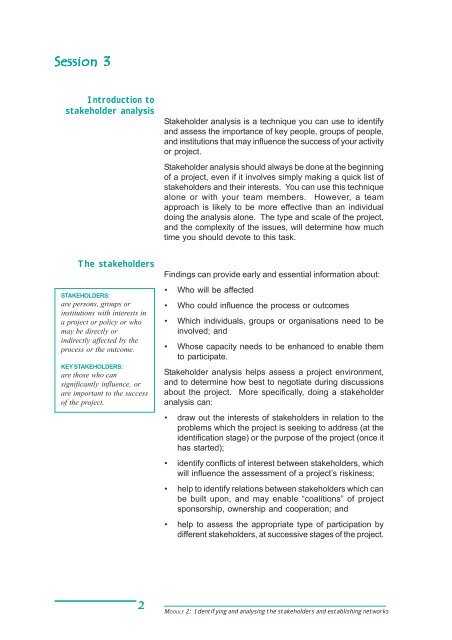MODULE 2: Identifying and analysing the stakeholders and ...
MODULE 2: Identifying and analysing the stakeholders and ...
MODULE 2: Identifying and analysing the stakeholders and ...
- No tags were found...
You also want an ePaper? Increase the reach of your titles
YUMPU automatically turns print PDFs into web optimized ePapers that Google loves.
Session 3Introduction tostakeholder analysisStakeholder analysis is a technique you can use to identify<strong>and</strong> assess <strong>the</strong> importance of key people, groups of people,<strong>and</strong> institutions that may influence <strong>the</strong> success of your activityor project.Stakeholder analysis should always be done at <strong>the</strong> beginningof a project, even if it involves simply making a quick list of<strong>stakeholders</strong> <strong>and</strong> <strong>the</strong>ir interests. You can use this techniquealone or with your team members. However, a teamapproach is likely to be more effective than an individualdoing <strong>the</strong> analysis alone. The type <strong>and</strong> scale of <strong>the</strong> project,<strong>and</strong> <strong>the</strong> complexity of <strong>the</strong> issues, will determine how muchtime you should devote to this task.The <strong>stakeholders</strong>STAKEHOLDERS:are persons, groups orinstitutions with interests ina project or policy or whomay be directly orindirectly affected by <strong>the</strong>process or <strong>the</strong> outcome.KEY STAKEHOLDERS:are those who cansignificantly influence, orare important to <strong>the</strong> successof <strong>the</strong> project.Findings can provide early <strong>and</strong> essential information about:• Who will be affected• Who could influence <strong>the</strong> process or outcomes• Which individuals, groups or organisations need to beinvolved; <strong>and</strong>• Whose capacity needs to be enhanced to enable <strong>the</strong>mto participate.Stakeholder analysis helps assess a project environment,<strong>and</strong> to determine how best to negotiate during discussionsabout <strong>the</strong> project. More specifically, doing a stakeholderanalysis can:• draw out <strong>the</strong> interests of <strong>stakeholders</strong> in relation to <strong>the</strong>problems which <strong>the</strong> project is seeking to address (at <strong>the</strong>identification stage) or <strong>the</strong> purpose of <strong>the</strong> project (once ithas started);• identify conflicts of interest between <strong>stakeholders</strong>, whichwill influence <strong>the</strong> assessment of a project’s riskiness;• help to identify relations between <strong>stakeholders</strong> which canbe built upon, <strong>and</strong> may enable “coalitions” of projectsponsorship, ownership <strong>and</strong> cooperation; <strong>and</strong>• help to assess <strong>the</strong> appropriate type of participation bydifferent <strong>stakeholders</strong>, at successive stages of <strong>the</strong> project.2<strong>MODULE</strong> 2: <strong>Identifying</strong> <strong>and</strong> <strong>analysing</strong> <strong>the</strong> <strong>stakeholders</strong> <strong>and</strong> establishing networks
















